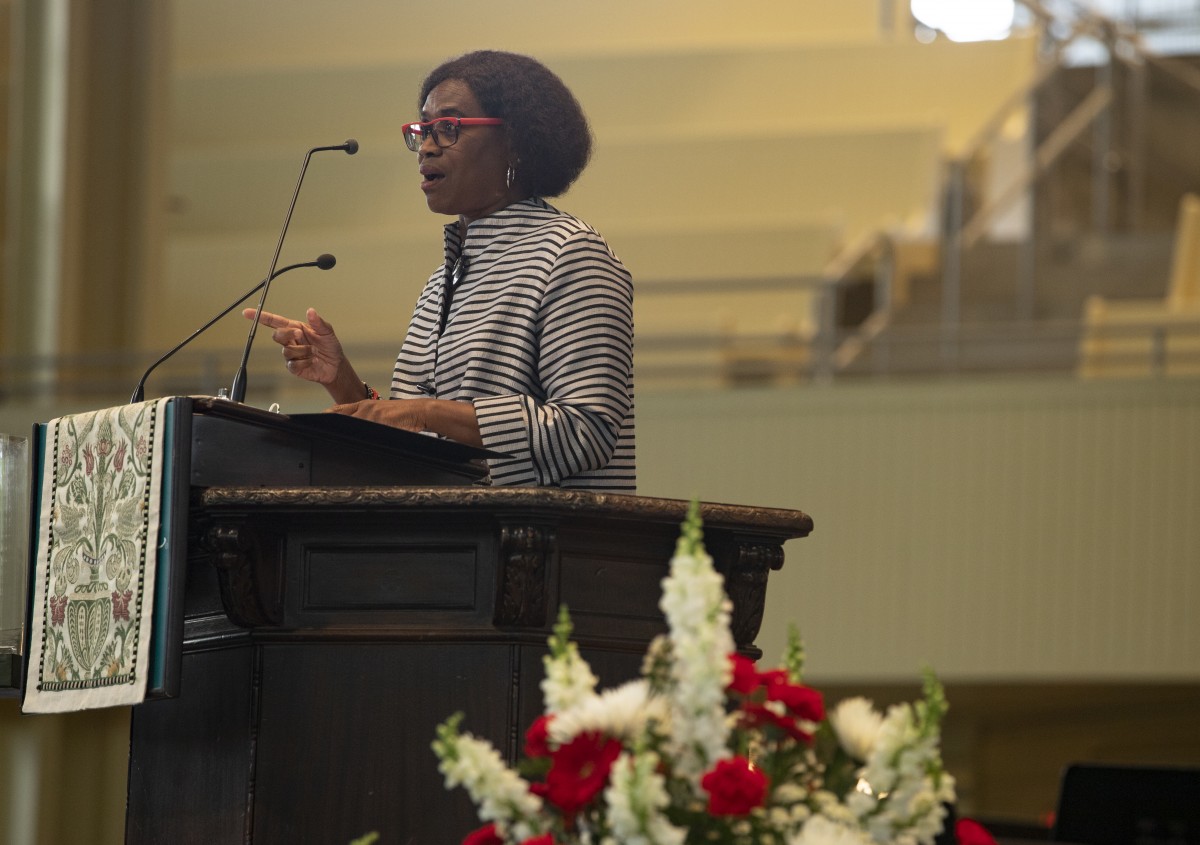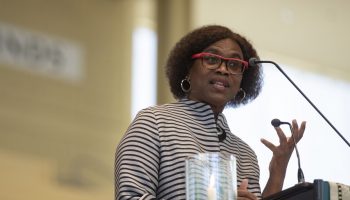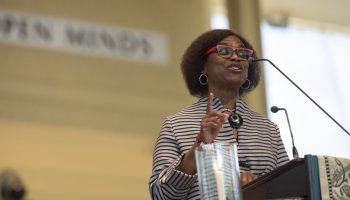It is so quiet here, I can’t gauge the time. There is no bus going by or a car back ring to tell me what time of day it is,” said the Rev. Irene Monroe at the 9:15 a.m. Monday morning worship service on Aug. 13.
Her sermon title was “The Conceptual Trap of Piety,” and the Scripture text was Matthew 27:32-37, the crucifixion of Jesus.
“I am meeting a lot of exciting people,” she said, “including Bryan Stevenson, who I don’t know, but I love him as a brother.”
Monroe called Stevenson, who was scheduled to speak at the 2 p.m. Monday, Aug. 13, interfaith lecture, a crusader for justice, fighting for the poor, oppressed, vulnerable and those with no hope.
She noted that as founder of the Equal Justice Initiative, Stevenson defends the poor, the wrongly condemned, women and children. He is behind the National Memorial for Peace and Justice, called the “Lynching Memorial.”
“We can’t feel the deep wounds of the era of racial terrorism until we tell the truth and understand the consequences of lynching and terror,” Monroe said.
Her spouse’s family came up north from the Mississippi Delta when her grandmother was threatened with rape. The grandmother’s brother accidently killed a white man while defending her, and the family left town that same night.
Monroe’s spouse’s great-uncle lived to be 102, “but he only saved one of five sisters from being raped,” she said.
Monroe said that she and her spouse would like to go to see the museum, but they are afraid to go out of Boston “because we are black and queer.”
“I don’t want to end up like Sandra Bland, whose death was explained away as self-induced asphyxiation, which I find very suspicious given the history of lynching in the black community,” Monroe said.
Where are black bodies safe in America, she asked.
The NAACP estimates that between 1882 and 1968, 4,743 people were lynched. Of that total number, 1,297 were white people, some of whom were gay or Jewish.
In 1913, Leo Frank, a Jewish businessman, was tried and convicted of the rape of a 13-year-old Christian, white girl. When his sentence was commuted in 1915, he was lynched.
Anti-Semitism was rapant at the time, and the Anti-Defamation League was founded in 1913 as a response to Frank’s conviction.
Ida B. Wells began documenting lynchings in 1893 after three young black businessmen were killed.
“She documented lynchings for the record and to bring lynching to national and international attention,” Monroe said.
Billie Holiday sang “Strange Fruit” in 1939, and Monroe said Time called it the best song of the time.
“Strange Fruit” was written by Abel Meeropol, who with his wife, Anne, adopted the two sons of Ethel and Julius Rosenberg, executed for being communist spies.
Monroe shared the lyrics of “Strange Fruit”:
“Southern trees bear a strange fruit,/ Blood on the leaves and blood at the root,/ Black bodies swinging in the Southern breeze,/ Strange fruit hanging from the poplar trees./ Pastoral scene of the gallant South,/ The bulging eyes and the twisted mouth,/ Scent of magnolias sweet and fresh,/ Then the sudden smell of burning flesh!”
“Where can my body be safe?” Monroe asked. “I asked Bishop Robinson if I could go for a walk around these grounds at 6 a.m. and not have the cops called out. He said, ‘honestly, I don’t know.’”
Monroe cited examples of places where white people were calling the cops on black people, including the two men at Starbucks waiting for a friend, people barbecuing in a park, someone delivering mail and Henry Louis Gates trying to get into his own apartment.
“Why do people call the cops on black people?” she said. “Because of some assumptions they make.”
These assumptions include that white discomfort is more important than black civil rights, law enforcement is seen as helpful to white people, the cops will come when white people call and white people are not mistaken for criminals and do not fear being shot or killed.
“I want you to wrestle with how are you white, and are you willing to be an ally in dismantling white supremacy?” Monroe said. “I want you to read the Bible with a hermeneutic of suspicion, as a person in a black body.”
The term “hermeneutics of suspicion” is usually attributed to Paul Ricoeur, who used it to describe interpreters who approach a text with the expectation that it doesn’t mean what it appears to.
Monroe challenged the congregation to look at the crucifixion as Jesus might have, in a Jewish body that was never safe from Roman persecution.
“This is a text of terror,” Monroe said. “Crucifixion was death by terror for opposition to the Roman state. Bodies were not buried; they were left to rot and as food for carrion-eaters.”
Monroe said she was troubled that Matthew’s text moved too fast from “violent death to resurrection.”
“Our culture does not sit well with pain,” she said. “We want fast resolutions to complicated problems. We are desensitized to the killing of the political and social opponents of the state.”
The messy parts of life are the teaching moments, she said. She told the congregation to look to the margins to get an honest critique of what is going on in the text and in the world.
Jesus was a threat to the Roman Empire and to some sects of Judaism.
“The unrelenting violence of Good Friday is tied to the violence today against people of color, women, Jews, Muslims and LGBT people,” she said.
Monroe said the murder of James Byrd in Jasper, Texas, in 1998, who was dragged behind a vehicle and dismembered for being black, and the death of Matthew Shepherd, who was bludgeoned and left to die in a crucified position because he was gay, influenced the 2009 hate crimes bill signed by President Barack Obama.
“The suffering servant image allows us to justify the suffering of others,” Monroe said. “We ritualize suffering as redemptive, but it is not redemptive. The image encourages the powerful to ignore suffering.”
Jesus did not die for our sins, she said. He died because of our sins, like black men hanging from trees in the South. Finally, in 2018, Congress put forward a bill making lynching a federal hate crime.
“I want you to use your bully pulpits and look at this text in light of Emmett Till,” she said. “Look at it in terms of my fear that if I get up to walk early, someone will call the cops on me.”
She told the congregation they “have the power to use (their white privilege).”
“How are you white? Make it possible for me to get up and walk,” she said.
Make it safe for just one other person, she said.
“Pastors, use your bully pulpit, and read the text with the hermeneutics of suspicion,” Monroe said. “You will be a better pastor, exposed to the texts of terror.”
And, she said, “you will be on the road to mitigate the terror of black, brown and queer bodies like myself.”
The Rt. Rev. V. Gene Robinson, vice president of religion and senior pastor, presided. The Rev. Natalie Hansen, a recently retired United Methodist pastor and co-host at the Methodist Missionary Home, read the Scripture. The Motet Choir, under the direction of Jared Jacobsen, organist and coordinator of worship and sacred music, sang “The Lord’s Prayer” by John Tavener. The Samuel M. and Mary E. Hazlett Memorial Fund and the John William Tyrrell Endowment for Religion provide support for this week’s services.





